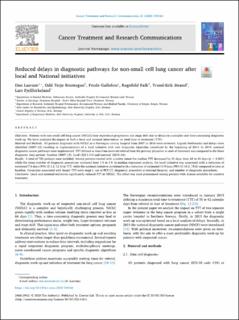| dc.contributor.author | Lærum, Dan | |
| dc.contributor.author | Brustugun, Odd Terje | |
| dc.contributor.author | Gallefoss, Frode | |
| dc.contributor.author | Falk, Ragnhild Sørum | |
| dc.contributor.author | Strand, Trond-Eirik | |
| dc.contributor.author | Fjellbirkeland, Lars | |
| dc.date.accessioned | 2021-06-17T13:07:28Z | |
| dc.date.available | 2021-06-17T13:07:28Z | |
| dc.date.created | 2020-07-20T11:54:13Z | |
| dc.date.issued | 2020 | |
| dc.Published | Cancer Treatment and Research Communications. 2020, 23 . | |
| dc.identifier.issn | 2468-2942 | |
| dc.identifier.uri | https://hdl.handle.net/11250/2760000 | |
| dc.description.abstract | Objectives
Patients with non-small cell lung cancer (NSCLC) may experience progression and stage shift due to delays in a complex and time-consuming diagnostic work-up. We have analyzed the impact of both a local and national intervention on total time to treatment (TTT).
Material and Methods
All patients diagnosed with NSCLC at a Norwegian county hospital from 2007 to 2016 were reviewed. Logistic bottlenecks and delays were identified (2007–12) resulting in implementation of a local initiative with new diagnostic algorithm introduced by the beginning of 2013. In 2015, national diagnostic cancer pathways were implemented. TTT defined as time from received referral from the primary physician to start of treatment was compared in the three diagnostic time periods; baseline (2007–12), local (2013–14) and national (2015–16).
Results
A total of 780 patients were included. Among patients treated with curative intent the median TTT decreased by 21 days, from 64 to 43 days (p < 0.001) while the mean number of diagnostic procedures increased from 3.5 to 3.9. In median regression analysis, the local initiative was associated with a reduction of estimated 7.8 days (95% CI 3.2, 12.3) in TTT, while the national initiative correlated with a reduction of estimated 14.9 days (95% CI 10.2, 19.6) compared to time at baseline. Covariates associated with longer TTT were stage I, use of PET-CT, diagnostic procedure at external hospital, and number of diagnostic procedures.
Conclusion
Local and national initiatives significantly reduced TTT in NSCLC. The effect was most pronounced among patients with disease available for curative treatment. | en_US |
| dc.language.iso | eng | en_US |
| dc.publisher | Elsevier | en_US |
| dc.rights | Attribution-NonCommercial-NoDerivatives 4.0 Internasjonal | * |
| dc.rights.uri | http://creativecommons.org/licenses/by-nc-nd/4.0/deed.no | * |
| dc.title | Reduced delays in diagnostic pathways for non-small cell lung cancer after local and National initiatives | en_US |
| dc.type | Journal article | en_US |
| dc.type | Peer reviewed | en_US |
| dc.description.version | publishedVersion | en_US |
| dc.rights.holder | Copyright 2020 The Authors | en_US |
| dc.source.articlenumber | 100168 | en_US |
| cristin.ispublished | true | |
| cristin.fulltext | original | |
| cristin.qualitycode | 1 | |
| dc.identifier.doi | 10.1016/j.ctarc.2020.100168 | |
| dc.identifier.cristin | 1819844 | |
| dc.source.journal | Cancer Treatment and Research Communications | en_US |
| dc.source.40 | 23 | |
| dc.identifier.citation | Cancer Treatment and Research Communications. 2020, 23, 100168 | en_US |
| dc.source.volume | 23 | en_US |

